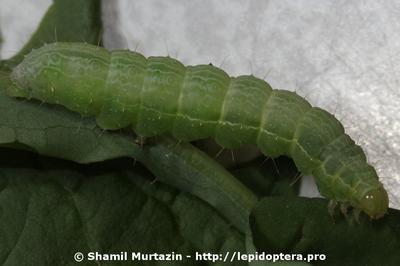Semilooper
Autographa nigrisigna
Insect
In a Nutshell
- Feeding damage on leaflets and pods.
- Shot-hole appearance on leaves.
- Occurrence of green larvae.
- Grey patterned moth on the plants.
Can also be found in
Symptoms
The semilooper feeds on leaflets and pods. Young larvae scrape the leaflets, while the grown-ups nibble on buds, flowers, pods, leaving the basal part of the pod with peduncle. While feeding on the pods, the looper leaves ragged and irregular damage of the pod wall. Leaves appear perforated and during a heavy infestation, leaves can be skeletonized. In severe cases, plants may become completely defoliated. Usually, symptoms are confused with bird damage.
Recommendations

Organic Control
Promote predator species like spiders, lacewings, ants and other natural enemies by avoiding the use of pesticides. Release Trichogramma chilonis at weekly intervals @ 1.5 lakh/ha for four weeks. Bio-insecticides based on NPV (Nucleopolyhedrovirus), Bacillus thuringiensis or Beauveria bassiana can also help to control semiloopers. Botanical products, such as neem extract and chilli or garlic extract can be sprayed on the foliage to control the pest. Apply NPV 250 LE/ha with Teepol 0.1% and Jaggery 0.5% thrice at 10-15 days interval commencing from the flowering stage. Apply Neem oil or Pungum oil 80 EC @ 2ml/lit.

Chemical Control
Always consider an integrated approach with preventive measures together with biological treatments. If more than 2 larvae are found per 10 plants, control measures must be started. Chlorpyriphos and Quinalphos are suggested to reduce semilooper population.
What caused it?
The damage is caused by the larvae of Autographa nigrisigna. The moth of the semilooper has patterned fore wings. The eggs are spherical and are laid in clumps of 40 eggs on the leaflets. The larvae and semilooper are green in colour. One generation takes about 4 weeks to develop. Egg period takes about 3-6 days and the larval period is completed in 8-30 days, while the pupal period occupies 5-10 days.
Preventive Measures
- Choose a tolerant variety.
- Avoid close plant spacing and late planting.
- Try to grow large and vital plants with a good fertilization and irrigation scheme.
- Monitor your plants at weekly intervals and check for the presence of larvae.
- Light and pheromone traps can be installed to check and kill the moth population.
- One light trap should be installed per 2 ha whereas pheromone traps are installed at a distance of 50 m @ 5 traps/ha.
- You can also install bird perches for predatory birds @ 50/ha.
- Grow tall sorghum as a comparison crop to serve as biological bird perches.
- Collect and destroy larvae and adults to the extent possible.
- Plough your field after harvest to make the pest accessible to predators.



